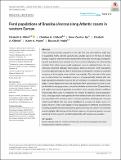Feral populations of Brassica oleracea along Atlantic coasts in western Europe
Abstract
There has been growing emphasis on the role that crop wild relatives might play in supporting highly selected agriculturally valuable species in the face of climate change. In species that were domesticated many thousands of years ago, distinguishing wild populations from escaped feral forms can be challenging, but reintroducing variation from either source could supplement current cultivated forms. For economically important cabbages (Brassicaceae: Brassica oleracea), “wild” populations occur throughout Europe but little is known about their genetic variation or potential as resources for breeding more resilient crop varieties. The main aim of this study was to characterize the population structure of geographically isolated wild cabbage populations along the coasts of the UK and Spain, including the Atlantic range edges. Double-digest restriction-site-associated DNA sequencing was used to sample individual cabbage genomes, assess the similarity of plants from 20 populations, and explore environment–genotype associations across varying climatic conditions. Interestingly, there were no indications of isolation by distance; several geographically close populations were genetically more distinct from each other than to distant populations. Furthermore, several distant populations shared genetic ancestry, which could indicate that they were established by escapees of similar source cultivars. However, there were signals of local adaptation to different environments, including a possible relationship between genetic diversity and soil pH. Overall, these results highlight wild cabbages in the Atlantic region as an important genetic resource worthy of further research into their relationship with existing crop varieties.
Citation
Mittell , E A , Cobbold , C A , Ijaz , U Z , Kilbride , E A , Moore , K A & Mable , B K 2020 , ' Feral populations of Brassica oleracea along Atlantic coasts in western Europe ' , Ecology and Evolution , vol. Early View . https://doi.org/10.1002/ece3.6821
Publication
Ecology and Evolution
Status
Peer reviewed
ISSN
2045-7758Type
Journal article
Description
EAM was funded by a University of Glasgow Lord Kelvin Adam Smith PhD studentship; UZI was funded by a NERC Independent Research Fellowship (NE/L011956); CAC is supported by the BBSRC (BB/P004202/1); KAM utilized equipment funded by the Wellcome Trust Institutional Strategic Support Fund (WT097835MF), Wellcome Trust Multi‐User Equipment Award (WT101650MA), and BBSRC LOLA award (BB/K003240/1). Part of the work was supported by a British Society for Plant Pathology summer studentship, and grants from the Botanical Research Fund, and the Blodwen Lloyd Bins trust funded through the Glasgow Natural History Society.Collections
Items in the St Andrews Research Repository are protected by copyright, with all rights reserved, unless otherwise indicated.

